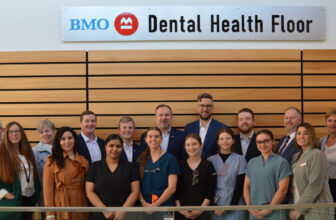
[adinserter block=”4″]
During National Dental Hygiene Month every October, we salute our amazing hygienists while raising awareness about the importance of keeping our teeth and gums healthy. You may have heard a term or two during your hygiene visit and wondered what it meant. Gingivitis? Periodontitis? Pocket depth? What do these actually mean? We’ve covered a few common hygiene terms to help you brush up on your oral health knowledge!
Enamel
Tooth enamel is the protective coating on the surface of your tooth. It is the hardest substance in the human body! Enamel protects the inside of your tooth, where nerves, blood vessels, and specialized cells and tissues provide nutrients for your tooth. Many things can harm your tooth enamel and cause decay, including sugary foods, dry mouth, teeth grinding and certain medications. Once your enamel is damaged, it cannot grow back. Brushing regularly with an electric toothbrush and fluoride toothpaste can help protect it.
Demineralization
Demineralization means your teeth are losing mineral content and your enamel is weakening. It is the first step before the tooth begins to decay and cavities form. Teeth with low mineral content may feel rougher, have white or brown spots, or become sensitive. Using fluoride helps to stop the process of demineralization and increases the mineral content of your teeth.
Erosion
Dental erosion is the loss of the enamel caused by acids you eat or drink, or acids coming up from your stomach, as in the case of acid reflux disease. Rinsing your mouth after consuming acidic foods or beverages, drinking water and using a fluoride toothpaste can help manage tooth erosion and prevent further enamel loss.
Decay
Tooth decay means that the enamel on the surface of your teeth has been damaged. The decay happens when bad bacteria accumulate in your mouth and make acids that attack your enamel. With repeated exposure, the acids can cause a hole, or cavity, in your tooth. A cavity is permanent damage to your tooth, but can be repaired with a filling. More severe cavities may require a root canal or crown.
Plaque
When bacteria accumulate on your teeth, they form a layer, or biofilm, commonly referred to as plaque. Plaque likes to make its home around your gum line and, left untreated, can cause your gums to pull away from your teeth, where more bacteria can accumulate.
Pocket depth
You may have heard your hygienist call out a series of numbers while examining your gums. What they are doing is measuring the pocket depth, which is the space between the gum and the tooth. To do this, your hygienist uses a dental probe that looks like a ruler. Measurements over four millimeters indicate some form of gum disease.
Gingivitis
Gingivitis is a mild form of gum disease. Gingivitis is marked by red, swollen gums with bleeding. At this stage, gum disease is still reversible. Twice-daily brushing and flossing, along with twice-yearly professional dental cleanings, can nip the problem in the bud. If you have gingivitis, your hygienist may recommend specific items you can use at home, such as electric toothbrushes, water flossers and mouth rinses.
Periodontitis (or periodontal disease)
This is the more severe form of gum disease. At this stage, it is no longer reversible. Periodontitis means deep pockets have formed at your gum line where thick plaque deposits and bacteria are accumulating, causing bone loss and inflammation throughout your body. While periodontitis cannot be reversed, proper treatment can help get the infection under control so it doesn’t get worse.
Periodontal maintenance
This is a special type of cleaning that helps keep periodontal disease under control. Because the aggressive bacteria involved in periodontal disease colonize quickly, ongoing therapy every three months is necessary to help stop the progression of the disease. An ultrasonic instrument is used to gently remove deposits and bacteria under the gums and at the base of the deep pockets that have formed, where regular brushing cannot reach.
Remember, your hygienist is your partner in oral health care! If you ever hear a word or phrase that you don’t quite understand, just ask. And don’t forget to schedule your next hygiene appointment!
[adinserter block=”4″]
Source link






